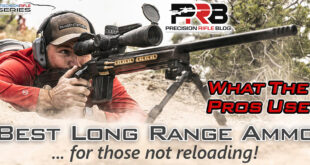The first step in load development for my new 7mm Remington Magnum (with a 27″ barrel) was to get a basic idea for the real-world muzzle velocities I could expect out of a few different high quality, very low drag bullets, so that I could compare them ballistically and decide which to pursure for further load development. I decided to try out the three bullets listed below after reading a great article on 7mm bullets by Nathan Foster.
I actually took all of these readings with a BRAND NEW BARREL (some of the first rounds out of it), so they aren’t representative of what the rifle after break-in … but likely won’t be off by more than 100 fps. (Update: After 100 rounds my fully broke in barrel shoots a 168gr VLD over 69.4gr of Retumbo at 2950 fps, so the velocities did increase slightly over the values below.)
The top-end powder charges were listed as max weights by the related bullet manufacturer. These were all recorded 8/18/2012 in the following conditions: 75 degrees, 60% humidity, with 29.86 in of pressure (3,200 ft elevation).
Berger 180gr VLD (G7 BC = 0.337, G1 BC = 0.659)
| Powder Type | Powder Weight | Muzzle Velocity |
| H1000 | 62.5 | 2608 |
| H1000 | 64.5 | 2665 |
| H1000 | 66.0 | 2713 |
| Retumbo | 63.0 | 2526 |
| Retumbo | 65.0 | 2681 |
| Retumbo | 66.4 | 2724 |
Berger 168gr VLD (G7 BC = 0.316, G1 BC = 0.617)
| Powder Type | Powder Weight | Muzzle Velocity |
| H1000 | 66.0 | 2780 |
| H1000 | 68.0 | 2881 |
| H1000 | 69.5 | 2887 |
| Retumbo | 66.0 | 2763 |
| Retumbo | 68.5 | 2869 |
| Retumbo | 70.4 | 2931 |
Hornady 162gr A-Max (G7 BC = 0.307, G1 BC = 0.599)
| Powder Type | Powder Weight | Muzzle Velocity |
| H1000 | 62.7 | 2619 |
| H1000 | 67.0 | 2827 |
| H1000 | 68.5 | 2875 |
I will say there was a noticeable increase in recoil with the 180gr VLD, although it was definitely less than 20%. I’ve shot an ultralight 7mm Rem Mag before, and it was nothing compared to that, but it wasn’t pleasant.
After looking at this data, and running it through some ballistic calculators … I’ve decided to first try to do load development for the Berger 168gr VLD. Although the 180gr VLD has a slightly higher BC, it comes with the cost of lower muzzle velocities and slightly higher recoil. Even if the kinetic energy at the muzzle is identical for the two bullets (which roughly indicates equal chamber pressure), that doesn’t mean recoil is equal. As Bryan Litz points out, “Recoil is tied to conservation of momentum, which is all together different from kinetic energy. The heavier bullet will generate more recoil when fired with the same muzzle energy than a lighter bullet.” The slightly higher BC simply doesn’t make up enough difference in wind drift at 1,000 yards to overcome the significantly flatter shooting and reduced recoil of the 168gr VLD. If I was only shooting at known distance targets, I might not end up at that decision … but because I also plan to use this rifle hunting and in unknown distance target competitions.
For a super in-depth comparison between the 168gr and 180gr VLDs see Bryan Litz’s articles.
Jump to another step:
- Part 1: Bullet Selection & Real-World Velocities
- Part 2: Audette’s Ladder Test
- Part 3: Optimal Charge Weight
- Part 4: 5 Shot Groups
 PrecisionRifleBlog.com A DATA-DRIVEN Approach to Precision Rifles, Optics & Gear
PrecisionRifleBlog.com A DATA-DRIVEN Approach to Precision Rifles, Optics & Gear





I have tried your ladder test and ended up with 69.4 gr. of retumbo except for brass I used mixed brass. The ogive at 2.657 and oal was 3.401 group 4 shots inside a dime 100 yards and under 1 inch at 230 not sure what my vol was but all I can say is thank you for the article. Oh buy the way this grouping cam out of a m77 7mag that is 20 years old. I am empressed with you and myself because I’m 60 and not much on target shooting . Thank you again for the well written article.